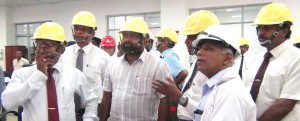News
Norochcholai plant shut down with grid failure
The Lakvijaya coal power plant in Norochcholai had experienced technical faults that aggravated the recent countrywide power failures and aided the collapse of the system, Ceylon Electricity Board (CEB) engineers said this week.

Norochcholai power plant: Minister of Power and Energy Ranjith Siyambalapitiya being briefed by site engineers. Pic by Hiran Priyankara
“Every time there was an imbalance in the system caused by various reasons such as being struck by lightning, the Lakvijaya coal power plant tripped,” said Bandula S Thilakasena, Additional General Manager (Corporate Strategy). “But it was not just tripping off. It went beyond that.”
“There were some technical faults within the plant such as the water in the boiler drum getting drained which should not have occurred,” he explained. “So we had to cool it down, repair it and start it again. That took some time.”
The plant is usually at a temperature of between 400-530 degrees centigrade.
“We are a little concerned about what happened,” he added. “We might have to investigate deep into this and why it took place. The Chinese manufacturers are helping. In a sense, the faults are major because the repercussions are so major. The reasons are not very clear to us at the moment.”
Previous issues with the coal power plant, which related to the condensers, have now been sorted out. No problems were experienced for the most part of 2015.
Athula Wanniarachchi, President of the Ceylon Electricity Board Engineers’ Union (CEBEU), also described issues experienced recently at Lakvijaya. “Particularly during the two recent failures, the way the Norochcholai Lakvijaya power plant reacted following the initiation of the failure had aggravated the failure and abetted the collapse.”
“There are two identified problems with the Lakvijaya plant,” he said. “They are its behaviour during the failure and after the failure. I will try to explain this in the simplest possible way but it is difficult to do so as these are highly technical issues.”
“Firstly, the Lakvijaya coal power plant’s behaviour during a failure,” Mr. Wanniarachchi said. “During a system disturbance, all grid connected power stations are expected to assist in maintaining the stability of the system. They are expected to increase and decrease their active power output, measured in megawatts, during frequency fluctuations and are also expected to generate or absorb what is known as reactive power during voltage fluctuations.”
“Due to an abnormality, the Lakvijaya governor controls reacted in a way that aggravated the ensuing disturbance after the initiation of the two recent disturbances,” he said. “This led to the ultimate collapse.”
After the grid failure, Lakvijaya should have shut down in a normal way following “safe shutdown procedure”. “Any grid-connected power plant is expected to face failures associated with the grid and they are expected to shut down normally and to resume generation when the grid is normalised,” Mr. Wanniarachchi said. “However, Lakvijaya did not shut down in the expected way and, as a result, we had to attend to minor maintenance work of replacing a boiler diaphragm before resuming operations. This is what took four days.”
“All other power plants in the system tripped with the grid failure but resumed generation after the grid was normalised, except Lakvijaya,” he pointed out.

